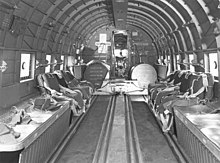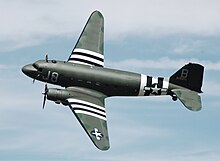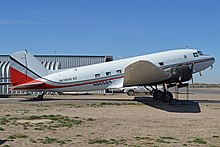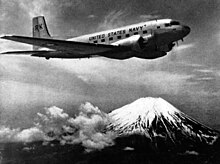Douglas C-47 Skytrain
| C-47 Skytrain C-53 Skytrooper Dakota | |
|---|---|
 | |
| A C-47 over Duxford D-Day Show 2014 | |
| Role | Military transport aircraft |
National origin | United States |
| Manufacturer | Douglas Aircraft Company |
| Designer | Douglas Aircraft |
| First flight | 23 December 1941[1] |
| Status | In service in Colombia, El Salvador and South Africa |
| Primary users | United States Army Air Forces Royal Air Force United States Navy Royal Canadian Air Force See operators |
Number built | 10,174 |
Developed from | Douglas DC-3 |
| Variants | Douglas XCG-17 Douglas AC-47 Spooky |
The Douglas C-47 Skytrain or Dakota (RAF designation) is a military transport aircraft developed from the civilian Douglas DC-3 airliner. It was used extensively by the Allies during World War II and remains in front line service with various military operators.[2]
Contents
1 Design and development
2 Operational history
2.1 World War II
2.2 Postwar era
2.3 Vietnam War
3 Super DC-3 (R4D-8)
4 Variants
4.1 RAF designations
5 Aftermarket conversions
6 Operators
7 Accidents and incidents
8 Surviving aircraft
9 Specifications (C-47B-DK)
10 See also
11 References
11.1 Notes
11.2 Citations
11.3 Bibliography
12 External links
Design and development
The C-47 differed from the civilian DC-3 in numerous modifications, including being fitted with a cargo door, hoist attachment, and strengthened floor, along with a shortened tail cone for glider-towing shackles, and an astrodome in the cabin roof.[3][4]
During World War II, the armed forces of many countries used the C-47 and modified DC-3s for the transport of troops, cargo, and wounded. The U.S. Naval designation was R4D. More than 10,000 aircraft were produced in Long Beach and Santa Monica, California and Oklahoma City, Oklahoma. Between March 1943 and August 1945 the Oklahoma City plant produced 5,354 C-47s.[2][5]
The specialized C-53 Skytrooper troop transport started production in October 1941 at Douglas Aircraft's Santa Monica, California plant. It lacked the cargo door, hoist attachment, and reinforced floor of the C-47. Only a total of 380 aircraft were produced in all because the C-47 was found to be more versatile.
Operational history
World War II

U.S. Army Pathfinders and USAAF flight crew prior to D-Day, June 1944, in front of a C-47 Skytrain at RAF North Witham
The C-47 was vital to the success of many Allied campaigns, in particular those at Guadalcanal and in the jungles of New Guinea and Burma, where the C-47 (and its naval version, the R4D) made it possible for Allied troops to counter the mobility of the light-travelling Japanese Army. Additionally, C-47s were used to airlift supplies to the embattled American forces during the Battle of Bastogne. Possibly its most influential role in military aviation, however, was flying "The Hump" from India into China. The expertise gained flying "The Hump" was later be used in the Berlin Airlift, in which the C-47 played a major role, until the aircraft were replaced by Douglas C-54 Skymasters.[citation needed]
In Europe, the C-47 and a specialized paratroop variant, the C-53 Skytrooper, were used in vast numbers in the later stages of the war, particularly to tow gliders and drop paratroops. During the invasion of Sicily in July 1943, C-47s dropped 4,381 Allied paratroops. More than 50,000 paratroops were dropped by C-47s during the first few days of the invasion of Normandy, France, in June 1944.[6] In the Pacific War, with careful use of the island landing strips of the Pacific Ocean, C-47s were even used for ferrying soldiers serving in the Pacific theater back to the United States.

C-47s unloading at Tempelhof Airport during the Berlin Airlift
About 2,000 C-47s (received under lend-lease) in British and Commonwealth service took the name "Dakota", possibly inspired by the acronym "DACoTA" for Douglas Aircraft Company Transport Aircraft.[7]
The C-47 also earned the informal nickname "gooney bird" in the European theatre of operations.[8] Other sources[9] attribute this name to the first aircraft, a USMC R2D—the military version of the DC-2—being the first aircraft to land on Midway Island, previously home to the long-winged albatross known as the gooney bird, which was native to Midway.
Postwar era
The United States Air Force's Strategic Air Command had Skytrains in service from 1946 through 1967. The US Air Force's 6th Special Operations Squadron was flying the C-47 until 2008.
With all of the aircraft and pilots having been part of the Indian Air Force prior to independence, both the Indian Air Force and Pakistan Air Force used C-47s to transport supplies to their soldiers fighting in the Indo-Pakistan War of 1947.
After World War II, thousands of surplus C-47s were converted to civil airline use, some remaining in operation in 2012, as well as being used as private aircraft.
Vietnam War
Several C-47 variations were used in the Vietnam War by the United States Air Force, including three advanced electronic warfare variations, which sometimes were called "electric gooneys" designated EC-47N, EC-47P, or EC-47Q depending on the engine used. Air International, Miami International Airport was a USAF military depot used to convert the commercial DC-3s/C-47s into military use. They came in as commercial aircraft purchased from third world airlines and were completely stripped, rebuilt, and reconditioned. Long range fuel tanks were installed with upgraded avionics and gun mounts. They left as first rate military aircraft headed for combat in Vietnam in a variety of missions. [Note 1] EC-47s were also operated by the Vietnamese, Laotian, and Cambodian Air Forces.[11] A gunship variation, using three 7.62 mm miniguns, designated AC-47 "Spooky", often nicknamed "Puff the magic dragon", also was deployed.[8]
Super DC-3 (R4D-8)

U.S. Navy C-117Ds at RAF Mildenhall in 1967
Large numbers of DC-3s and surplus C-47s were in commercial use in the United States in the 1940s. In response to proposed changes to the Civil Air Regulations airworthiness requirements that would limit the continuing use of these aircraft, Douglas offered a late 1940s DC-3 conversion to improve takeoff and single-engine performance. This new model, the DC-3S or "Super DC-3", was 39 in (0.99 m) longer. It allowed 30 passengers to be carried, with increased speed to compete with newer airliners. The rearward shift in the center of gravity led to larger tail surfaces and new outer, swept-back wings. More powerful engines were installed along with shorter, jet ejection-type exhaust stacks. These were either 1,475 hp (1,100 kW) Wright R-1820 Cyclones or 1,450 hp (1,081 kW) Pratt & Whitney R-2000 Twin Wasps in larger engine nacelles. Minor changes included wheel well doors, a partially retractable tailwheel, flush rivets, and low drag antenna. These all contributed to an increased top speed of 250 mph (400 km/h; 220 kn). With greater than 75% of the original DC-3/C-47 configuration changed, the modified design was virtually a new aircraft.[12] The first DC-3S made its maiden flight on 23 June 1949.[13]
The changes fully met the new FAR 4B airworthiness requirements, with significantly improved performance. However, little interest was expressed by commercial operators in the DC-3S. It was too expensive for the smaller operators which were its main target: only three were sold to Capital Airlines. The U.S. Navy and U.S. Marine Corps had 100 of its R4D aircraft modified to Super DC-3 standards as the R4D-8, later redesignated C-117D.[14]
Variants

Paratroop C-47, 12th Air Force Troop Carrier Wing, invasion of southern France, 15 August 1944

Interior view of Douglas C-47, Hendon Aerodrome, England

Aircraft of the 6th Special Operations Squadron including a C-47T in use by the U.S. Air Force, c. 2005

C-47B Skytrain -serial 43-49942

A former USAAF C-47A Skytrain which flew from a base in Devon, England, during the D-Day Normandy invasion and shows "invasion stripes" on her wings and fuselage.

Douglas C-53 Skytrooper, c/n 4935, operated by a skydiving service at Eloy, Arizona.

Douglas C-47 Skytrain Dakota “Old Number 30”

Douglas C-47 Skytrain Dakota “Old Number 30” door

C-47 Skytrain cockpit
- C-47
- Initial military version of the DC-3 with four crew (Pilot, Co-Pilot, Navigator, and Radio Operator) and seats for 27 troops alongside the fuselage interior. "Aerial Ambulances" fitted for casualty evacuation could carry 18 stretcher cases and a medical crew of three. 965 built (including 12 for the United States Navy as R4D-1).
- C-47A
- C-47 with a 24-volt electrical system, 5,254 built including USN aircraft designated R4D-5
- RC-47A
- C-47A equipped for photographic reconnaissance and ELINT missions
- SC-47A
- C-47A equipped for Search Air Rescue; redesignated HC-47A in 1962
- VC-47A
- C-47A equipped for VIP transport role
- C-47B
- Powered by R-1830-90 engines with two-speed superchargers (better altitude performance) to cover the China-Burma-India routes, 3,364 built
- VC-47B
- C-47B equipped for VIP transport role
- XC-47C
- C-47 tested with Edo Model 78 floats for possible use as a seaplane [15][16]
- C-47D
- C-47B with second speed (high blower) engine supercharger disabled or removed after the war
- AC-47D Spooky
- Gunship aircraft with three side-firing .30 in (7.62 mm) Minigun machine guns
- EC-47D
- C-47D with equipment for the Electronics Calibration, of which 26 were so converted by Hayes in 1953; prior to 1962 was designated AC-47D
- NC-47D
- C-47D modified for test roles
- RC-47D
- C-47D equipped for photographic reconnaissance and ELINT missions
- SC-47D
- C-47D equipped for Search Air Rescue; redesignated HC-47D in 1962
- VC-47D
- C-47D equipped for VIP transport role
- C-47E
- Modified cargo variant with space for 27–28 passengers or 18–24 litters
- C-47F
- YC-129 redesignated, Super DC-3 prototype for evaluation by USAF later passed to USN as XR4D-8
- C-47L/M
- C-47H/Js equipped for the support of American Legation United States Naval Attache (ALUSNA) and Military Assistance Advisory Group (MAAG) missions
- EC-47N/P/Q
- C-47A and D aircraft modified for ELINT/ARDF mission, N and P differ in radio bands covered, while Q replaces analog equipment found on the N and P with a digital suite, redesigned antenna equipment and uprated engines
- C-47R
- One C-47M modified for high altitude work, specifically for missions in Ecuador
- C-53 Skytrooper
- Troop transport version of the C-47 that lacked the reinforced cargo floor, large cargo door, and hoist attachment of the C-47 Skytrain. It was dedicated for the troop transport role and could carry 28 passengers in fixed metal seats arranged in rows in the former cargo space; 221 built.
- XC-53A Skytrooper
- One testbed aircraft modified in March 1942 with full-span slotted flaps and hot-air leading edge de-icing. Converted to C-53 standard in 1949 and sold as surplus.
- C-53B Skytrooper
- Winterised and long-range Arctic version of the C-53 with extra fuel tanks in the fuselage and separate navigator's astrodome station for celestial navigation; eight built.
- C-53C Skytrooper
- C-53 with larger port-side access door; 17 built.
- C-53D Skytrooper
- C-53C with 24V DC electrical system and its 28 seats attached to the sides of the fuselage; 159 built.
- C-117A Skytrooper
- C-47B with 24-seat airline-type interior for staff transport use, 16 built.
- VC-117A
- Three redesignated C-117s used in the VIP role
- SC-117A
- One C-117C converted for air-sea rescue
- C-117B/VC-117B
- High-altitude superchargers removed, one built and conversions from C-117As all later VC-117B
- C-117D
- USN/USMC R4D-8 redesignated C-117D in 1962.
- LC-117D
- USN/USMC R4D-8L redesignated LC-117D in 1962.
- TC-117D
- USN/USMC R4D-8T redesignated TC-117D in 1962.
- VC-117D
- USN R4D-8Z redesignated VC-117D in 1962.
- YC-129
- Super DC-3 prototype for evaluation by USAF redesignated C-47F and later passed to USN as XR4D-8. Wright R-1820 engines uprated to 1425 hp.
- CC-129
- Canadian Forces designation for the C-47 (post-1970)
- XCG-17
- One C-47 tested as a 40-seat troop glider with engines removed and faired over
- R4D-1 Skytrain
- USN/USMC version of the C-47
- R4D-3
- Twenty C-53Cs transferred to USN
- R4D-5
- C-47A variant 24-volt electrical system replacing the 12-volt of the C-47; redesignated C-47H in 1962, 238 transferred from USAF
- R4D-5L
- R4D-5 for use in Antarctica. Redesignated LC-47H in 1962. Photos of this type show the removal of underslung engine oil coolers typical of the R-1830 engine installation; apparently not needed in the cold polar regions.
- R4D-5Q
- R4D-5 for use as special ECM trainer. Redesignated EC-47H in 1962
- R4D-5R
- R4D-5 for use as a personnel transport for 21 passengers and as a trainer aircraft; redesignated TC-47H in 1962
- R4D-5S
- R4D-5 for use as a special ASW trainer; redesignated SC-47H in 1962
- R4D-5Z
- R4D-5 for use as a VIP transport; redesignated VC-47H in 1962

JMSDF R4D-6Q.

USN R4D-8 from VR-23 Codfish Airline over Mount Fuji, 1952

United States Navy R4D-8
- R4D-6
- 157 C-47Bs transferred to USN; redesignated C-47J in 1962
- R4D-6L, Q, R, S, and Z
- Variants as the R4D-5 series; redesignated LC-47J, EC-47J, TC-47J, SC-47J, and VC-47J respectively in 1962
- R4D-7
- 44 TC-47Bs transferred from USAF for use as a navigational trainer; redesignated TC-47K in 1962
- R4D-8
- R4D-5 and R4D-6 remanufactured aircraft with stretched fuselage, Wright R-1820 engines, fitted with modified wings and redesigned tail surfaces; redesignated C-117D in 1962
- R4D-8L
- R4D-8 converted for Antarctic use, redesignated LC-117D in 1962
- R4D-8T
- R4D-8 converted as crew trainers, redesignated TC-117D in 1962
- R4D-8Z
- R4D-8 converted as a staff transport, redesignated VC-117D in 1962
RAF designations

A Dakota IV in RAF Transport Command colors, owned by the Classic Air Force, operating out of Coventry Airport
- Dakota I
- RAF designation for the C-47 and R4D-1.
- Dakota II
- RAF designation for nine C-53 Skytroopers received under the lend lease scheme. Unlike the majority of RAF Dakotas, these aircraft were therefore dedicated troop transports, lacking the wide cargo doors and reinforced floor of the C-47.
- Dakota III
- RAF designation for the C-47A.
- Dakota IV
- RAF designation for the C-47B.
- Airspeed AS.61
- Conversion of Dakota I aircraft
- Airspeed AS.62
- Conversion of Dakota II aircraft
- Airspeed AS.63
- Conversion of Dakota III aircraft
- BEA Pionair/Dart-Dakota
- Conversion of Dakota to Rolls-Royce Dart power and used by BEA to prove turboprop engines prior to entry into service of Vickers Viscount. [17]
Aftermarket conversions
Operators

A Battle of Britain Memorial Flight Dakota with open parachute door at Duxford in 2008
 Argentina
Argentina Australia
Australia Belgium
Belgium Benin
Benin Biafra
Biafra Bangladesh
Bangladesh Bolivia
Bolivia Brazil
Brazil Burma
Burma Cambodia
Cambodia Canada[18]
Canada[18] Chad
Chad Chile
Chile Republic of China
Republic of China People's Republic of China
People's Republic of China Colombia
Colombia Republic of the Congo
Republic of the Congo DR Congo
DR Congo Cuba
Cuba Czechoslovakia
Czechoslovakia Denmark
Denmark Dominican Republic
Dominican Republic Ecuador
Ecuador Egypt
Egypt El Salvador
El Salvador Ethiopia
Ethiopia Finland
Finland France
France Gabon
Gabon Nazi Germany[19]
Nazi Germany[19] Germany
Germany Greece
Greece Guatemala
Guatemala Haiti
Haiti Honduras
Honduras Hungary
Hungary Iceland
Iceland India
India Indonesia
Indonesia Iran
Iran Israel
Israel Italy
Italy Ivory Coast
Ivory Coast Jordan
Jordan Japan
Japan Kenya
Kenya South Korea
South Korea Laos
Laos Libya
Libya Madagascar
Madagascar Malawi
Malawi Mali
Mali Mauritania
Mauritania Mexico
Mexico Monaco
Monaco Morocco
Morocco Netherlands
Netherlands New Zealand
New Zealand Nicaragua
Nicaragua Niger
Niger Nigeria
Nigeria Northern Rhodesia[20]
Northern Rhodesia[20] Norway
Norway Oman
Oman Pakistan
Pakistan Panama
Panama Papua New Guinea
Papua New Guinea Paraguay
Paraguay Peru
Peru Philippines
Philippines Poland
Poland Portugal
Portugal Rhodesia
Rhodesia Romania
Romania Rwanda
Rwanda Saudi Arabia
Saudi Arabia Senegal
Senegal South Africa
South Africa Somalia
Somalia Soviet Union (also as Lisunov Li-2)
Soviet Union (also as Lisunov Li-2) Sri Lanka
Sri Lanka Spain
Spain Sweden
Sweden Singapore
Singapore Syria
Syria Tanzania
Tanzania Thailand
Thailand Togo
Togo Turkey
Turkey Uganda
Uganda Uruguay
Uruguay United Kingdom
United Kingdom United States
United States Venezuela
Venezuela Vietnam
Vietnam South Vietnam
South Vietnam Yemen
Yemen Yugoslavia
Yugoslavia Zaire
Zaire Zambia[20]
Zambia[20]
Accidents and incidents

Memorial in remembrance of a 1954 C-47 crash, Alaska Veterans Memorial
Surviving aircraft
Large numbers of C-47s, C-117s and other variants survive, on display in museums or as monuments; operated as warbirds; or remaining in service.
Specifications (C-47B-DK)

Data from McDonnell Douglas Aircraft since 1920 [21]
General characteristics
Crew: four (pilot, co-pilot, navigator, radio operator)
Capacity: 28 troops
Payload: 6,000 lb (2,700 kg)
Length: 63 ft 9 in (19.43 m)
Wingspan: 95 ft 6 in (29.41 m)
Height: 17 ft 0 in (5.18 m)
Wing area: 987 ft2 (91.70 m2)
Airfoil: NACA2215 / NACA2206
Empty weight: 18,135 lb (8,226 kg)
Loaded weight: 26,000 lb (11,793 kg)
Max. takeoff weight: 31,000 lb (14,061 kg)
Powerplant: 2 × Pratt & Whitney R-1830-90C Twin Wasp 14-cylinder radial engines, 1,200 hp (895 kW) each
Performance
Maximum speed: 224 mph (195 kn, 360 km/h) at 10,000 ft (3,050 m)
Cruise speed: 160 mph (139 kn, 257 km/h)
Range: 1,600 mi (1,391 nmi, 2,575 km)
Ferry range: 3,600 mi (3,130 nmi, 5,795 km)
Service ceiling: 26,400 ft (8,045 m)
Climb to 10,000 ft (3,050 m): 9.5 min
See also
Related development
- Basler BT-67
- Douglas AC-47 Spooky
- Douglas DC-3
- Douglas XCG-17
- Lisunov Li-2
- Showa/Nakajima L2D
Aircraft of comparable role, configuration and era
- Curtiss C-46 Commando
Junkers Ju 52/3m
Related lists
- List of aircraft of World War II
- List of military aircraft of the United States
- List of military aircraft of the United States (naval)
- List of non-carrier aircraft flown from aircraft carriers
References
Notes
^ Air International out of Miami International Airport was a military depot used by the air force to convert the DC-3s into military use.[10]
Citations
^ C-47 Skytrain Military Transport Historical Snapshot Boeing. Retrieved: 29 June 2017.
^ ab Parker 2013, pp. 13, 35, 37, 39, 45-47.
^ Wilson, Stewart. Aircraft of WWII. Fyshwick, ACT, Australia: Aerospace Publications Pty Ltd., 1998. .mw-parser-output cite.citationfont-style:inherit.mw-parser-output .citation qquotes:"""""""'""'".mw-parser-output .citation .cs1-lock-free abackground:url("//upload.wikimedia.org/wikipedia/commons/thumb/6/65/Lock-green.svg/9px-Lock-green.svg.png")no-repeat;background-position:right .1em center.mw-parser-output .citation .cs1-lock-limited a,.mw-parser-output .citation .cs1-lock-registration abackground:url("//upload.wikimedia.org/wikipedia/commons/thumb/d/d6/Lock-gray-alt-2.svg/9px-Lock-gray-alt-2.svg.png")no-repeat;background-position:right .1em center.mw-parser-output .citation .cs1-lock-subscription abackground:url("//upload.wikimedia.org/wikipedia/commons/thumb/a/aa/Lock-red-alt-2.svg/9px-Lock-red-alt-2.svg.png")no-repeat;background-position:right .1em center.mw-parser-output .cs1-subscription,.mw-parser-output .cs1-registrationcolor:#555.mw-parser-output .cs1-subscription span,.mw-parser-output .cs1-registration spanborder-bottom:1px dotted;cursor:help.mw-parser-output .cs1-ws-icon abackground:url("//upload.wikimedia.org/wikipedia/commons/thumb/4/4c/Wikisource-logo.svg/12px-Wikisource-logo.svg.png")no-repeat;background-position:right .1em center.mw-parser-output code.cs1-codecolor:inherit;background:inherit;border:inherit;padding:inherit.mw-parser-output .cs1-hidden-errordisplay:none;font-size:100%.mw-parser-output .cs1-visible-errorfont-size:100%.mw-parser-output .cs1-maintdisplay:none;color:#33aa33;margin-left:0.3em.mw-parser-output .cs1-subscription,.mw-parser-output .cs1-registration,.mw-parser-output .cs1-formatfont-size:95%.mw-parser-output .cs1-kern-left,.mw-parser-output .cs1-kern-wl-leftpadding-left:0.2em.mw-parser-output .cs1-kern-right,.mw-parser-output .cs1-kern-wl-rightpadding-right:0.2em
ISBN 1-875671-35-8.
^ Parker 2013, pp. 37, 39, 45-47.
^ Herman 2012, pp. 202-203, 227.
^ Cacutt, Len. "The World's Greatest Aircraft," Exeter Books, New York, NY, 1988.
ISBN 0-7917-0011-9.
^ "History: Douglas C-47 Skytrain Military Transport". Boeing. Retrieved: 14 July 2015.
^ ab O'Rourke, G.G, CAPT USN. "Of Hosenoses, Stoofs, and Lefthanded Spads". United States Naval Institute Proceedings, July 1968.
^ C-47/R4D Skytrain units of the Pacific and CBI, David Isby, Osprey Combat Aircraft #66, Osprey Publishing Limited, 2007
^ "Chronological History of the EC-47's Location by Tail Number." ec47.com. Retrieved: 7 April 2009.
^ Rickard, J. "Douglas EC-47N". historyofwar.org, 12 November 2008. Retrieved: 7 April 2009.
^ Super DC-3 dc3history.org. Retrieved: 23 June 2010.
^ Francillon 1979, pp. 464–465.
^ Francillon 1979, pp. 466–467.
^ "Aviation in Long Pants" (photo of XC-47C). Popular Mechanics, July 1944.
^ "DC-3s On Floats." YouTube, 8 November 2008. Note: first part has rare World War II film footage and narration by project manager for the XC-47C.
^ "1952 | 3204 | Flight Archive". Flightglobal.com. 1951-08-15. Retrieved 2018-06-27.
^ "Douglas DC-3 (CC-129) Dakota." Archived 2011-06-11 at the Wayback Machine DND - Canada's Air Force. Retrieved: 14 October 2009.
^ "Das Archiv der Deutschen Luftwaffe." (in German) LuftArchiv.de. Retrieved: 5 July 2010.
^ ab "Trade Registers". Armstrade.sipri.org. Retrieved 2013-06-20.
^ Francillon 1979, p. 261.
Bibliography
.mw-parser-output .refbeginfont-size:90%;margin-bottom:0.5em.mw-parser-output .refbegin-hanging-indents>ullist-style-type:none;margin-left:0.mw-parser-output .refbegin-hanging-indents>ul>li,.mw-parser-output .refbegin-hanging-indents>dl>ddmargin-left:0;padding-left:3.2em;text-indent:-3.2em;list-style:none.mw-parser-output .refbegin-100font-size:100%
- Chorlton, Martyn. Paths in the Wood. Cowbit, UK: Old Forge Publishing Ltd, 2003.
ISBN 0-9544507-0-1. - Donald, David. The Complete Encyclopedia of World Aircraft. New York: Barnes & Noble, 1997.
ISBN 0-7607-0592-5. - Flintham, Victor. Air Wars and Aircraft: A Detailed Record of Air Combat, 1945 to the Present. New York: Facts on File, 1990.
ISBN 0-8160-2356-5. - Francillon, René J. McDonnell Douglas Aircraft Since 1920. London: Putnam & Company Ltd., 1979.
ISBN 0-370-00050-1. - Gradidge, Jennifer M. The Douglas DC-1, DC-2, DC-3: The First Seventy Years. Two volumes. Tonbridge, UK: Air-Britain (Historians) Ltd., 2006.
ISBN 0-85130-332-3. - Herman, Arthur. Freedom's Forge: How American Business Produced Victory in World War II. New York: Random House, 2012.
ISBN 978-1-4000-6964-4. - Kaplan, Philip. Legend: A Celebration of the Douglas DC-3/C-47/Dakota. Peter Livanos & Philip Kaplan, 2009.
ISBN 978-0-9557061-1-0. - Parker, Dana T. Building Victory: Aircraft Manufacturing in the Los Angeles Area in World War II. Cypress, California: Dana Parker Enterprises, 2013.
ISBN 978-0-9897906-0-4. - Pearcy, Arthur Jr. "Douglas R4D variants (US Navy's DC-3/C-47)". Aircraft in Profile, Volume 14. Windsor, Berkshire, UK: Profile Publications Ltd., 1974, pp. 49–73.
ISBN 0-85383-023-1. - Yenne, Bill. McDonnell Douglas: A Tale of Two Giants. Greenwich, Connecticut: Bison Books, 1985.
ISBN 0-517-44287-6.
External links
| Wikimedia Commons has media related to C-47 Skytrain. |
Manual: (1943) T.O. No. 01-40NC-1 Pilot's Flight Operating Instructions C-47 Airplane[dead link]
"Our Tow Ships". National WWII Glider Pilots Association, Inc. 09 July 2014.
